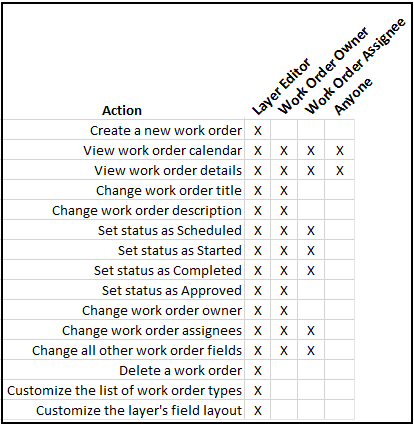Table of Contents
Work Order Permissions
Permissions work differently on a work order layer compared to other layers. When you grant a user edit permission to a regular layer that gives them the ability to add features, modify any feature, and delete any feature. But with work orders, a user can have a different level of permission on different work orders depending on their assigned role with each work order feature. This allows more people to participate in the job of managing work orders while still maintaining some level of control.
The table below lists all the different actions a user might want to perform on their work orders. And the four columns on the right show the various roles that are allowed to perform each action. "Layer Editor" refers to any person with edit permission for the work order layer. "Work Order Owner" refers to the person who was marked as the owner of a specific work order, "Work Order Assignee" refers to the person(s) who a work order was assigned to. And "Anyone" refers to all users listed on your account.

Notes:
By default the Work Order Owner is the person who created the work order. However, the user creating the work order can create the work order on behalf of someone else and therefore mark someone else as the owner.
Users who are layer editors have unlimited control allowing them to make changes to any work order even if they aren't the owner or the person who created the work order.
There can only be one owner assigned to each work order but there can be any number of assignees.
The concept of "Owner" is the person who is ultimately responsible for the task getting completed and therefore the person who the workers (ie. assignees) would otherwise report back to when it is done.. This is usually the same person who creates the work order. This is commonly a supervisor or secretary.
The concept of "Assignee" is the person(s) who is most likely to actually do the job. Note from the table above that the assignee has the ability to re-assign a work order to someone else.
When you are creating a work order for yourself (ie. you are the owner and assignee) you can just leave the assignee blank if you want since you already have sufficient permission to do everything you want as the owner. Although it may be good record keeping to go ahead and list yourself as the assignee anyway.
For some systems you may want to make everyone a layer editor so that anyone can make any change to any work order. That way you don't have to deal with the hassle of managing permissions. But other systems may want to limit the adding of new work orders to only certain people to avoid duplications and maintain more control
Example
Michelle is the only user with edit permission on the work order layer. This means that Michelle is the only person who can create new work orders. Michelle creates two work orders and assigns one of them to Bob and assigns the other one to both Tom and Bob. Bob can then add notes and update the completion status of either work order. Tom can do the same but only for the second work order. Michelle is the only person who can mark the work order as approved.
